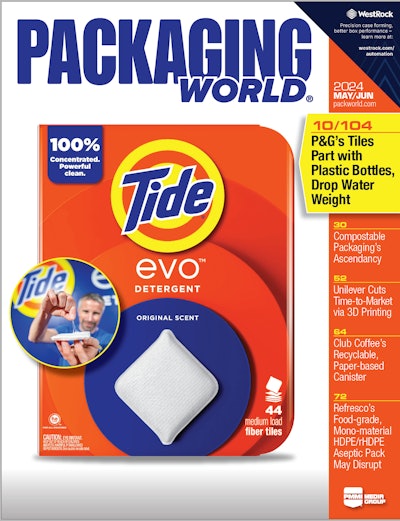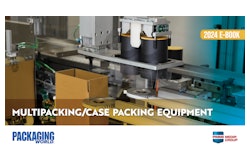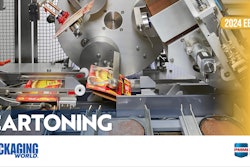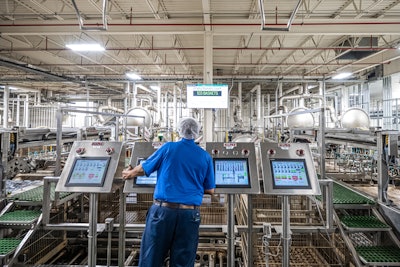
Crider Foods, a contract food manufacturer and packager in Stillmore, Ga., is the leading U.S. producer of canned chicken, turkey, ham, pork, and beef products. Through automation of its retort system, Crider Foods has transformed its operations and, in the process, upskilled its workforce while taking a great leap in environmental sustainability through reduced water consumption. The company has also endowed university-level technical education to prepare the next generation of process engineers.
From its beginnings in 1944 as a family fish and poultry market in Douglas, Ga., Crider Foods today centers its business around canned chicken as its lead product. Now, as it annually packs millions of pounds of canned protein, there is no manual handling of cans at the Crider plant from the time the cans enter the facility to when they leave.
A quest to increase capacity
The path to automated packaging began in 2010 at an inflection point for the company. From 2008 to 2010, the Crider Foods retorting operation neared production capacity. The simple answer for increasing capacity at the time seemed to be to purchase cost-effective retorts, expand the retort room, and hire additional employees for loading and unloading baskets and retorts by hand as well as for palletizing.
 Crider’s lead product is canned chicken, seen here being diced and filled into cans.
Crider’s lead product is canned chicken, seen here being diced and filled into cans.
Then, Crider began working with Allpax, a product brand of ProMach, a leading U.S. manufacturer of retorts and automated batch retort systems (ABRS). After touring the Stillmore plant and listening to Crider’s goals, Allpax proposed a fully automated retort system that would cut down on manual operations and significantly increase capacity. The higher cost of the proposed system, not to mention the worker upskilling issue, left the Crider evaluation team intrigued but cautious.
Allpax invited key managers, including second-generation owner and present chairman William (Billy) Crider Jr., to tour a recently installed ABRS-based canning operation in Illinois. The Allpax technical sales team wanted Crider Foods to experience the benefits of automation and have the opportunity to talk with end-users about their experience with the recently installed automated batch retort system.
“It felt like I had stepped into the future,” Crider said later about the tour. “I saw in my mind’s eye high-speed canning lines at our Stillmore plant feeding a similar automated retort system, and I understood what that would mean for transforming our family-owned business. At the end of the tour, I said to the Allpax sales team we wanted an automated system like the one we just saw.”
New can handling approach
During the tour, Crider and his team saw a single operator running 8 Allpax jumbo retorts from a control platform overlooking the room. Cans were automatically swept in layers into and out of retort baskets. An automated shuttle traveling at 270 fpm loaded and unloaded the bank of eight retorts and the system tracked the baskets, ensuring that every can went through the correct cooking process.
The ABRS system could load/unload baskets at a rate of 550 cans per minute, depending on can size with smaller cans running faster than 550. The Allpax operation and record-keeping software complied with FDA guidelines. Allpax provided this customer 24/7 remote technical support via a secure virtual private network.
“Plant personnel informed us that production was up with the new automated system and labor input virtually disappeared,” Crider says.
Shortly after the tour, Allpax designed a retort operation for Crider with eight six-basket saturated steam vessels with the option of adding water spray capabilities later. The ABRS portion of the system consisted of two loading/unloading stations for the baskets and a three-basket shuttle.
 With no manual handling of cans at the facility, the automated shuttle system loads and unloads baskets into Allpax retorts.
With no manual handling of cans at the facility, the automated shuttle system loads and unloads baskets into Allpax retorts.
Installation in Stillmore went smoothly as Allpax manufactured all the equipment. Crider Foods reports there were no issues with components not integrating properly, which they chalk up to being an advantage of working with a single-source supplier. Retort room staff decreased from approximately 20 down to three or four. New employees were hired for some of the more specialized jobs and other personnel were reassigned to various departments within the plant.
Upstream and downstream upgrades
Upstream of the retort room, Crider Foods upgraded fillers and seamers on its canning lines and ran those lines at a higher speed to accommodate the increased capacity in the retort room.
On the downstream end, Crider transformed 40,000 sq ft of warehouse space into a new end-of-line packaging room with new high-speed packaging lines featuring automated inspection, labeling, tray packaging, and palletizing equipment. Like the canning lines, end-of-line operations saw a significant reduction in staffing needs.
Having additional personnel available for other departments eased staffing issues in those departments. Today, there is one operator and one recorder per canning and packaging line and one operator and one recorder for the palletizing operation.
The Crider retort room now features 15 Allpax static retorts for cans and 5 dual-mode retorts capable of saturated steam and water spray with overpressure, which are used for cans or for the new pouch lines of ready-to-eat chicken products. From the time the empty cans are depalletized to the time the full cans are packed into trays and palletized, no human touches them.
Workforce investments
During and after the installation in 2011, Crider Foods launched an intensive training program. The state of Georgia supported training through its Quick Start program, where technical colleges provide customized workforce training for companies creating jobs. Crider also hired a private training organization to assist in multi-skills training.
The maintenance staff was given extensive training in all aspects of automation, including best practices in preventive maintenance. Preventive maintenance keeps the automated systems running in like-new condition. Maintenance personnel were involved in the planning for the new lines and provided important insights about what was needed in a new high-speed/high-capacity environment.
The concerted effort of upskilling the workforce paid off in optimal overall equipment effectiveness, quality, and safety. For example, the plant recently held a month-long celebration when it reached 2 million hours without lost time due to accident or injury.
 Automated sterilization transformed Crider’s operations both upstream and downstream of these vessels.
Automated sterilization transformed Crider’s operations both upstream and downstream of these vessels.
“We wanted to help develop a program that will produce more of the fantastic engineering talent we’ve already been hiring from Georgia Southern and help the University become a source of engineering talent for the entire Southeast,” says William (Billy) Crider III, CEO.
“This gift will help apply and develop technology to solve problems due to labor shortages, processing inefficiencies, and supply chain disruptions, while establishing an experienced high-tech workforce in southeast Georgia,” says Mohammad Davoud, dean of the Allen E. Paulson College of Engineering and Computing.
Crider regularly arranges tours of the plant for high school students. Students are surprised and intrigued by the high level of technology, especially when they witness technicians walking the floors with tablets held in their hands. The company hopes to show students that 21st-century food production can offer fulfilling and well-paying careers.
In 2011, Stillmore phased out poultry processing to make more room for canning, fully cooked frozen chicken, and warehouse space and today purchases poultry and other meats from leading processors. The plant increased from a quarter of a million sq ft to half a million. The Crider Foods operation in Stillmore is staffed by more than 700 people. Employee retention and morale are high, Crider reports. Further, values of supporting co-workers run throughout the organization.
Quality assurance value as benchmarks
 A team member removes cans of chicken after filling and before the seamer for quality control.
A team member removes cans of chicken after filling and before the seamer for quality control.
- All incoming meat is checked to raw material quality specifications and temperature requirements. All raw material is X-rayed for bones and foreign material
- All raw material is weighed before and after marination to ensure consistent results
- All can labels are scanned and validated to match the inkjet code on the can to ensure the correct label has been applied
- All cans are given a final X-ray to remove any dented cans or cans with potential bones or foreign material
- Can seams are verified through digital imaging equipment
- Crider’s onsite lab samples all production runs to ensure sodium, fat, and protein levels are consistent
Employees closely monitor every production run. The plant holds a Level 3 SQF Certification and has received numerous SQF “excellent” ratings. The plant has a GOLD Certificate of Recognition from Silliker, the leading international network of accredited food testing and consulting laboratories.
Pilot plants and water savings
Stillmore also has a 6,000-sq-ft pilot plant. Most of the pieces of equipment in the pilot facility are smaller versions of equipment on the line, from marination injectors, to tumblers, ovens, and fillers. Similar equipment aids in scaling up from pilot lines to full production.
An Allpax 2402 Multi-Mode laboratory retort is an essential piece of equipment for R&D and piloting as it has the same software as the production system, so the plant is assured of quality once the parameters are set. The machine’s various modes can be used to find the optimum recipe.
Retorts are the largest consumers of water at Stillmore, mostly from cooling the cans after processing. The plant added filtration/recycling systems and has reduced water consumption by 66%. Outside the retort room, washing cans offers another opportunity to cut consumption and operation is examining other ways to cut down on use.
 Following sterilization, labeled cans continue to the palletizer.
Following sterilization, labeled cans continue to the palletizer.
Water leaving the plant is screened for meat particles and any protein captured is collected and sent to a rendering plant. Water then goes through a Dissolved Air Flotation (DAF) water treatment process that clarifies wastewater by removal of fats, phosphates, starches, proteins, and other suspended solids, oils, and greases. Phosphate and other useful chemicals are collected and used as a natural agricultural fertilizer for the company’s 500 acres of farmland where Rey grass is grown in the winter and Bermuda grass in the summer.
Following the DAF process, water passes through an aeration facultative pond, then an aeration pond, which further cleans the H20. A holding pond of clean water supplies an irrigation system for the grass-growing operation.
In addition to making the plant more energy efficient, water reduction at the plant is also a step towards sustainability, which Crider Jr. says is good for the environment and business.
“The majority of our brand owners and retailer customers have supplier sustainability goals, and we are proud to show them our accomplishments,” says Crider Jr. "Making these investments is the right thing to do in terms of looking to the future and what we are leaving for those who come after us.”
A vision of the future where automation paved a new path for Crider Foods has in the years since transformed the company. Crider Foods has been feeding families for 80 years and confidently knows it will continue to do so in the future.





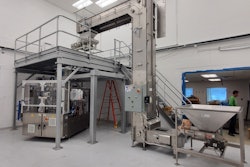
.jkBzux4bVh.jpg?crop=focalpoint&fit=crop&fp-x=0.5&fp-y=0.5&h=167&w=250&auto=format%2Ccompress&q=70)







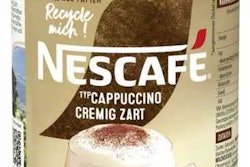
%20(1).hp5KDMRm7b.jpg?crop=focalpoint&fit=crop&fp-x=0.5&fp-y=0.5&h=167&w=250&auto=format%2Ccompress&q=70)






